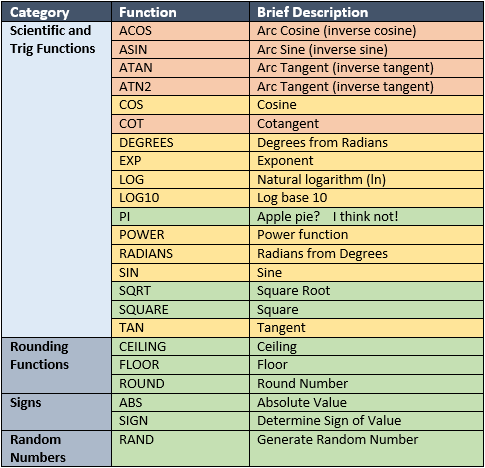Think about a scenario where you’re dealing with a dataset full of product prices. You need to round those prices up to the nearest dollar for a promotional campaign or round them down to the nearest cent for accounting purposes. This is where SQL’s CEIL and FLOOR functions come in handy – two powerful tools for rounding numeric values up or down, respectively. They are the data wranglers in SQL, helping you shape your data in just the right way. But how do these functions differ, and how can you choose the right one for your data manipulation needs?

Image: pediaa.com
Let’s embark on a journey to understand the intricacies of CEIL and FLOOR in SQL. This guide will shed light on their distinct behaviors and illustrate their practical applications, equipping you with the knowledge to leverage these functions with confidence.
The Essence of Rounding in SQL
At their core, CEIL and FLOOR are SQL functions that are designed for rounding numeric values—either up (CEIL) or down (FLOOR)—to the nearest integer. While this sounds simple, their precision and flexibility make them invaluable tools for various data manipulation tasks.
CEIL: The Ceiling Function
The CEIL function, short for “ceiling,” takes a numeric value and rounds it up to the nearest integer. It’s like picturing a ceiling—the value you provide is always “contained” within the ceiling, which in this analogy, represents the next highest integer.
Example:
Let’s take the example of product prices. If you have a product priced at $4.50 and you want to round it up to the nearest dollar, you would use the CEIL function like this:
SELECT CEIL(4.50); This SQL statement will return 5 as the output, effectively rounding 4.50 up to the nearest whole number, which is 5.

Image: viewfloor.co
FLOOR: The Floor Function
Contrary to CEIL, the FLOOR function rounds a numeric value down to the nearest integer. Imagine a floor—the value you provide will always be “resting” on that floor, which represents the next lowest integer.
Example:
Let’s say you’re working with product quantities and need to round them down to the nearest whole number. If your quantity is 7.8, using the FLOOR function would look like this:
SELECT FLOOR(7.8);The SQL statement will return 7, rounding the value of 7.8 down to the nearest whole number.
Key Differences in a Nutshell
Here’s a concise table to highlight the key differences between CEIL and FLOOR:
| Feature | CEIL | FLOOR |
|---|---|---|
| Rounding Direction | Up | Down |
| Nearest Integer | Next highest | Next lowest |
| Example | CEIL(3.2) = 4 | FLOOR(3.2) = 3 |
Real-World Applications of CEIL and FLOOR
Beyond simple rounding, CEIL and FLOOR functions have several real-world applications in SQL:
- Pricing and Discounts: Round prices up to the nearest dollar for promotional campaigns or round down to the nearest cent for accurate accounting records.
- Inventory Management: Adjust quantities upwards using CEIL to account for potential overages or round down quantities using FLOOR to avoid overstocking.
- Shipping and Logistics: Calculate shipping costs based on rounded weight amounts using either CEIL or FLOOR to align with carrier requirements.
- Data Analysis: Round metric values to the nearest whole number for clearer visualizations or reporting.
Expert Insights and Actionable Tips
Here’s some advice from SQL gurus to make the most of CEIL and FLOOR:
- Understand the Context: Before employing either CEIL or FLOOR, carefully consider the context of your data and the desired outcome. Is rounding up or down the correct approach for the specific data manipulation task?
- Utilize Precision: For scenarios requiring fine-grained control over rounding, consider using the ROUND function in SQL, which allows you to round values to a specific decimal place.
- Test and Validate: After applying CEIL or FLOOR, always verify the results against your expectations. This ensures accuracy and avoids erroneous calculations.
Difference Between Ceil And Floor In Sql
https://youtube.com/watch?v=GRNll4SQL84
Conclusion
By understanding the distinct nature and applications of CEIL and FLOOR in SQL, you gain a significant edge in data manipulation. These functions empower you to refine numerical values, adapting them for a wide range of practical situations. Remember to analyze your data, understand the desired outcome, and test your results to maximize the effectiveness of these powerful SQL functions. Let your data journey be guided by these tools, and you’ll witness the transformative power of precise rounding in every step of your SQL ventures.





